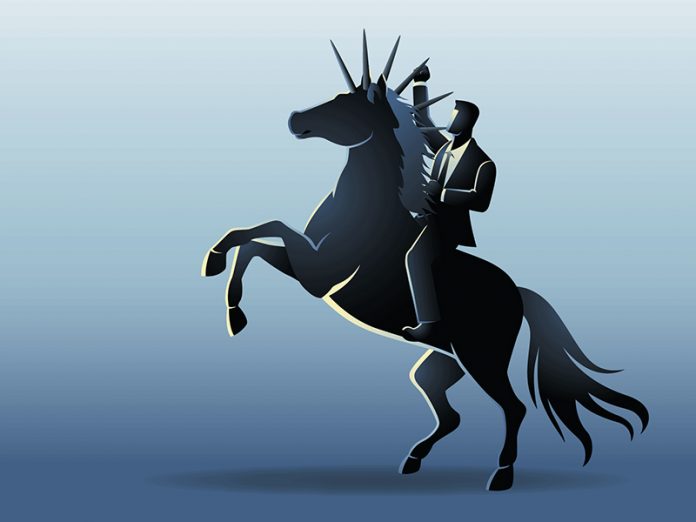Start-ups – and their unicorn, and now decacorn, darlings – are critical both for value creation as well as for economic growth and job creation. Regarding value, the US Private Equity sector has generated 1.8 times more returns from its startups financing than what the S&P 500 has generated over the last 20 years1. Regarding economic growth, new US firms (those surviving their first 5 years of operations), have been able to deliver more than twice the productivity growth of the US economy under the same time frame.
The start-up star of the last decade: the Unicorn
Some start ups have been even more stellar than the average. About ten years ago, the buzz came about being a “unicorn”3, – i.e. a start-up which was privately valued by venture capitalists and other private investors at more than USD 1 Billion. On top of being a major milestone in valuation, those start ups were exceptional on multiple counts. While being only a few (less than 50 by 2013), they were planting the seed of new household names such as Uber, Zynga or Skype; had reached valuation of magnitude 6 times the original capital raised4 generating IRR >65% for investors, and profit size that was often enough to return the full portfolio hurdle rate promised by their VC investors.
The new kid on the block: the Decacorn
Since the early spot of the first list of 50 “unicorns” ten years ago, a lot has happened. Quite a few went the IPO route (often generating a extra public value premium of 35% in the first month of their debut), or got acquired by major strategic investors (such as Skype and LinkedIn by Microsoft).

The short group of elite start ups has also expanded significantly. Even if they represent still less than 1% of the 100,000 of prevailing start ups which have received funding to date, more than 1000 of them exist today, meaning that the specie has been able to expand by 50% a year.5
What’s next, then? The new phenomenon is another exclusive premium club, called the “decacorns”6, welcoming companies valued at more than USD 10 Billion. This club includes companies such as from Databricks, Stripe and ByTeDance (home to TikTok), – companies which add to the early exceptional “decacorns” of the past ten years ago, such as Facebook and Palantir, (both having since exited the club through IPO).
By late 2021, this cumulative set of decacorns will soon be one hundred, – or just below 1/10 of the population of unicorns. This size is noticeable as this current club of decacron is now bigger than the original number of unicorns7, when buzz emerged about them.
Spotting a decacorn: Five common features
At the speed at which the club of decacorns expands, it might become mainstream – with about 800 of them by end of the decade. One possible hypothesis is that this club of decacorn is simply the club of unicorns that is becoming older. So why should we bother. But our research demonstrates that a decacorn is not an older unicorn, but has rather unique features that also set the decacorn apart from the old star of unicorns. We uncover five:
1. Decacorns emerge out of a virtuous cycle of value creation.
Pending the year analysed, approximately 9% of unicorns have become decacorns in the last decade. Looking billion by billon to reach the decacorn status, each extra billion has only a 65% chance to bring the next one closer to the decacorn club. What is remarkable for the decacorn is that it has managed to double the success rate from the low side valuation to the valuation close to reach the threshold of decacorn.
Quantitatively, a decacorn has had a 35% conversion rate to next billion when valued between 1-3 billion, but increases it to 80% when it passes the 5 billion valuation. The higher the valuation, the more likely the next billion will come to reach the decacorn status.
2. Decacorns grow business as easily as early start ups, – but with long term resilience.
The above shows that decacorns are not just unicorns at a 10X valuation, 10 years later. In fact, the average decacorn is 10.5 years old, making a 10X growth in valuation in just half the duration (3,5 years versus 7 years) of the unicorn.
This rapid valuation boost implies that, on average, a decacorn company has been doubling its growth every year for over a decade. Most early start ups should have this growth ambition at their early days, to hope to secure early funding, and a lot of start-ups have not achieved that. Furthermore, high growth may arise for a short time, as a burst of energy to take-off and succeed. Think like the gazelles and the cheetahs in their run for life (survival or food).
Yet the challenge is to get this energy to last. Decacorns sustain this pace for a decade on average. This is resilient speed on steroid.
3. Decacorns are born global.
Decacorns sustain this massive value growth because of their vision of the “world is flat”. The first ever European Decacorn, Uipath, born out of Romania, designed a global growth strategy from its onset, so that the company could cover as much of the robotic automation market as possible. It designed a global distribution presence, from New York to the rest of the world in no time, and borrowed scale from its ecosystem partners.8 Another example is ByTeDance which quickly realized that it needed to scale globally as a blowback from China, (his CEO was reported in 2016 to say that global was a must, as China was only 1/5 of internet usage and this that it would be impossible to compete “without resources allocation on global level and scale effect on the other 4/5” of the digital universe).9 ByteDance kicked off its globalization pace 5 years ago, including competitors acquisition eg in Indonesia and the US to establish a quick leadership presence across the globe. By now, TikTok has representative offices in close to 200 offices wordwide.
Further, as Stripe for secure payments, or BioNtech for Covid vaccines demonstrate, the massive growth of decacorns can be facilitated by a global appeal of products/ applications. Decacorns also rely on early technologies with vast opportunities, e.g. genomics in the case of BioNtech, AI for ByTeDance and DataBricks, or still blockchain crypto for FTX.
4. Decacorns are more capital efficient.
We have estimated that, for the top 25 most valued decacorns to date, the ratio of value to capital injected is close to 10 versus about 6 for unicorns. This ratio even goes to 12 when we take out decacorns that rely on infrastructure-based business models that require major investment, such as SpaceX, or F&T Express.
5. Everywhere can be a place to become a decacorn.
The wisdom has been that Silicon Valley is the place for success, at least for tech start ups. The world of unicorns, when spotted 10years ago, was concentrated in Silicon Valley, and today, still about 50% of unicorns are born out of the US, and 20% of those US unicorns are managed by Indian founders,10 who had decided to try their luck in what they claim is the most world successful statrtup ecosystem.
By current trends, decacorns seem more often to be emerging from all over the world. From Celonis to Klarna or Checkout, a promising number of them has even been appearing in Europe. Europe’s decacorns conversion rate from to unicorns in Europe reaches 13%, or 65% better rate then the US unicorns. More specifically the UK, Germany, and Sweden – have experienced a real surge in decacorns, with more than 10 new ones in 2021 alone.
About the Author

Jacques Bughin is a professor of Management, Chaire Gillet of Management Practice, at the Solvay Brussels School of Economics and Management at Université libre de Bruxelles (ULB), and among others, a former Director of McKinsey and of the McKinsey Global Institute. He advises Antler and Fortino Capital, two major VC/PE firms, and serves on the Board of multiple companies.
References
- https://www.cambridgeassociates.com/private-investment-benchmarks/
- C:\Users\bughi\Downloads\Decker, R. A., J. Haltiwanger, R. S. Jarmin, and J. Miranda (2017):Caldwell, C. 2009. Identity, self-awareness, and self-deception: Ethical implications for leaders and organizations. Journal of Business Ethics, 90: 393-406.
- https://www.researchgate.net/publication/305755434_What_Big_Companies_Can_Learn_from_the_Success_of_the_Unicorns
- https://www.researchgate.net/profile/Ken-Wiles-2/publication/343778343_The_Growing_Blessing_of_Unicorns_The_Changing_Nature_of_the_Market_for_Privately_Funded_Companies/links/5f6a0dc1299bf1b53ee9aed9/The-Growing-Blessing-of-Unicorns-The-Changing-Nature-of-the-Market-for-Privately-Funded-Companies.pdf
- https://www.fortinocapital.com/blog/how-to-become-unicorn
- https://news.crunchbase.com/news/decacorn-startups-2021-global-record-data-charts/
- https://news.crunchbase.com/news/decacorn-startups-2021-global-record-data-charts/
- https://www.uipath.com/hubfs/idceconomicimpact.pdf
- https://news.cgtn.com/news/2020-08-08/ByteDance-an-algorithm-backed-firm-with-globalization-ambitions–SNbGeeF0pq/index.html#:~:text=ByteDance%20started%20its%20global%20development%20strategy%20in%202015%2C,app%20Flipagram%20and%20its%20news%20product%20New%20Republic.
- https://www.indiatimes.com/worth/news/ninety-founders-amongst-five-hundred-usa-unicorns-are-india-born-559560.html


































